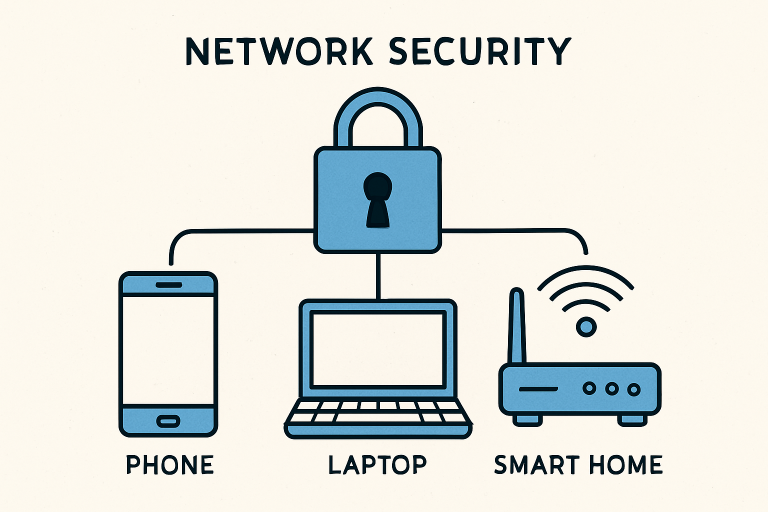Key Takeaways
- Implementing strong passwords and multi-factor authentication enhances account security.
- Regular software updates and the use of antivirus programs protect against malware.
- Utilizing Virtual Private Networks (VPNs) secures data transmission over the internet.
- Being cautious with emails and links helps prevent phishing attacks.
- Securing home Wi-Fi networks prevents unauthorized access.
Table of Contents
- Introduction
- Creating Strong Passwords
- Enabling Multi-Factor Authentication
- Keeping Software Updated
- Utilizing Virtual Private Networks (VPNs)
- Exercising Caution with Emails and Links
- Securing Home Wi-Fi Networks
- Implementing Firewall Protection
- Conclusion
Introduction
In today’s interconnected world, maintaining the security of your digital interactions has become as crucial as locking your front door. Whether sending personal messages, shopping online, or managing finances, robust network security prevents cybercriminals from intercepting your information and exploiting vulnerabilities. As our dependence on digital technology deepens, adequate safeguards like a secure wireless network are vital to preserve privacy and integrity across all online activities.
Network security isn’t just a concern for tech experts—everyone benefits from implementing best practices at home and on the go. Vigilance against cyber threats is necessary, with new risks emerging daily. Understanding the essentials of strong security is the first step toward ensuring your digital life remains safe from intruders seeking to exploit weaknesses.
Creating Strong Passwords
Establishing strong and unique passwords for each account is the most practical defense against unauthorized access. Instead of using predictable combinations such as “password123” or familiar names, create passwords with a mix of uppercase and lowercase letters, numbers, and special characters. Aim for passphrases of at least twelve characters. A reputable password manager can also help you keep track of multiple complex passwords without sacrificing convenience. According to Consumer Reports, a strong password strategy is a proven shield against data breaches.
Enabling Multi-Factor Authentication
Multi-factor authentication (MFA) significantly improves account security by requiring additional verification beyond your password. Standard MFA methods include temporary codes sent via SMS or email, or generated by an authentication app, and biometric methods like fingerprint or facial recognition. These safeguards mean that even if a password is compromised, access to your accounts remains protected. Enabling MFA on your most sensitive accounts, such as banking and email, should be a top priority for every user.
Keeping Software Updated
One of the most frequently overlooked aspects of strong network security is keeping software, operating systems, and applications current. Every update or patch released by developers is designed to improve functionality and address vulnerabilities that cybercriminals actively exploit. Users leave doors open for malware, ransomware, and data breaches by delaying or ignoring updates. Setting devices to update automatically is a proactive step that ensures you don’t miss critical fixes. Manufacturers consistently release patches in response to emerging threats, making regular updates one of the most cost-effective ways to stay protected. History shows that outdated software has been the gateway to major cyberattacks, proving that timely updates are your easiest and most reliable defense.

Utilizing Virtual Private Networks (VPNs)
A Virtual Private Network (VPN) reinforces your privacy by encrypting your internet traffic. This is especially crucial when connecting to public Wi-Fi at cafes, airports, or hotels. A VPN prevents malicious third parties from intercepting sensitive information such as login credentials or financial details. For frequent travelers or remote workers, a VPN is a must-have tool for maintaining digital hygiene in unsecured environments. Wirecutter provides comprehensive reviews to help you select a trustworthy VPN provider.
Exercising Caution with Emails and Links
Email remains one of the most common cyberattack channels, including phishing schemes that lure users into revealing confidential data or downloading malware. Be skeptical of unsolicited emails, even those appearing to come from organizations you trust. Check sender addresses carefully, and never click on suspicious links or download unfamiliar attachments. If uncertain, confirm requests through official contact information before taking action. Staying alert to common phishing tactics can help prevent costly mistakes.
Securing Home Wi-Fi Networks
Your home Wi-Fi network, if left unsecured, can act as an open door for cyber intruders seeking to exploit vulnerabilities. One of the first and most essential steps is changing the router’s default name and password, which are often easily guessed by attackers. Enabling the latest security protocols, such as WPA3 encryption, adds an extra layer of defense to safeguard sensitive data. Creating a strong, unique Wi-Fi password—and updating it periodically—helps reduce the risk of unauthorized access. It’s equally essential to restrict network access to trusted devices and disable features you don’t use, like guest networks or remote management. Implementing these proactive measures significantly lowers the chances of intrusion and keeps your connected smart devices secure.
Implementing Firewall Protection
Firewalls are one of the most important defenses in cybersecurity, as a protective barrier between your devices and the wider internet. By monitoring incoming and outgoing traffic, they detect and block unauthorized access attempts that could expose systems to malware, hackers, or data theft. Many modern routers and operating systems come with built-in firewalls, but it’s essential to confirm they are enabled and, when necessary, adjust settings for greater control. For those managing sensitive or confidential information, layering hardware and software firewalls adds stronger protection against evolving threats. Regularly reviewing firewall logs can provide early warning of suspicious activity, allowing users to respond proactively before vulnerabilities are exploited and severe damage occurs.
Conclusion
Adopting comprehensive network security measures is no longer optional—it’s essential for protecting personal and professional digital spaces. Simple actions like creating strong, unique passwords, enabling multi-factor authentication (MFA), and regularly updating systems go a long way toward minimizing risks. Each practice reduces the likelihood of falling victim to cyberattacks such as phishing, malware, or unauthorized access attempts. However, technology alone isn’t enough; vigilance and proactive habits play an equally critical role. Staying alert to suspicious activity, avoiding unsafe networks, and practicing safe browsing habits help create a layered defense. By integrating these strategies into daily routines, individuals gain peace of mind, knowing their privacy, identity, and sensitive information are safeguarded against constantly evolving cyber threats.








